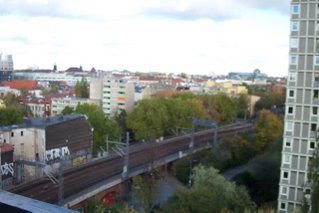
It is not easy to choose an apartment to buy in a city like this where there are so many interesting possibilities and so many unknown factors. Below are some of our choices. We encourage our friends to offer their opinions, either via the comments or directly to us via email.
BARTNINGALLE 7
This is a particularly handsome building in the architecturally notable Hansa Quarter. The apartment is on the 12th and 13th floor, with a stairway leading up half a flight to the living room / dining room / kitchen area, and then another stairway leading half a flight up to the bedrooms and bathrooms. It has an east-facing balcony, west and north facing windows, and stunning views in all directions. The apartment itself is light and handsome – a real piece of architectural art with new wood floors and a new kitchen. It is relatively large 904 sqft, and and the monthly costs are high because the building is just getting new pipes, etc. It is the most expensive of the set at about 50% more than we paid for our E. Lansing condo.

BARTNINGALLE 9
This is another Hansa Quarter building with an award winning architect. The apartment is on the 11th floor with west and north views. The kitchen is good, the floorplan very efficient so that it seems larger than it actually is (818 sqft). Renovations on the building are complete so the monthly costs are in a normal (300 €) range. It lacks a private balcony, but has access to a common balcony that seems little used. The asking price is a mere 60% of the asking price of Bartningalle 7 (about equal to our EL condo). We have been warned, however, that apartments without balconies can be hard to sell or rent.

LESSINGSTR 8
This comparatively ordinary building (not one of the architectural prize winners), which means that it is not under any historic preservation protection (and therefore updating infrastructure is cheaper). I have not actually seen the apartment yet (a renter is there for some more weeks), but I did see sample apartment in the identical neighboring building and liked it. The views are west toward the river (though whether the river is visible is not clear). It has a balcony and a practical floorplan. It is small (785 sqft) and may need some modernization within the apartment. The price is the lowest of any (85% of our EL condo), so some investment may be reasonable. The location is within 5 minutes of the two buildings above, and they are all less than 5 minutes from the S-Bahn , the U-Bahn, and a decent grocery store.

ALTONAER 12
A very well-known Brazilian architect designed this building, which has a few oddities, such as an elevator that stops only on the ground floor, 5th floor, and top floor. Since this is a 5th floor apartment, that is not an issue, but the 5th floor has other odd features, such as a wide lobby space that was meant originally as a commons, but simply is not used. None of the apartments on that floor have balconies. The apartment itself was redone recently. It is totally soundproofed, has a good kitchen and new bath. The decoration is a bit baroque, complete with hand-crafted moldings along the ceiling, which was certainly not what the architect had in mind in the 1950s. Its price is almost the same as Bartningalle 9. The price is essentially the same as Bartningalle 9 and equal to our EL condo. The east-facing view is good and the location virtually next to Bartningalle 7.

Le COBUSIER BUILDING
This internationally famous and enormous building has 500 apartments and a layout that is hard to describe. Most apartments are maisonettes, meaning that they are on two floors with internal stairs. This apartment is large (1140 sqft) and has breathtaking 16th floor views, two balconies, and a view from the dining room window that makes you forget your food. It has all been redone recently in exquisite taste that fits perfectly with the building. Its drawbacks are the location – out by the Olympic stadium where drunken soccer fans roam – and a very long, narrow floor plan with windows only at each end. The owner has used the internal space intelligently for the bathroom and storage. The asking price is nearly as much as Bartningalle 7 (140% of the EL condo).











